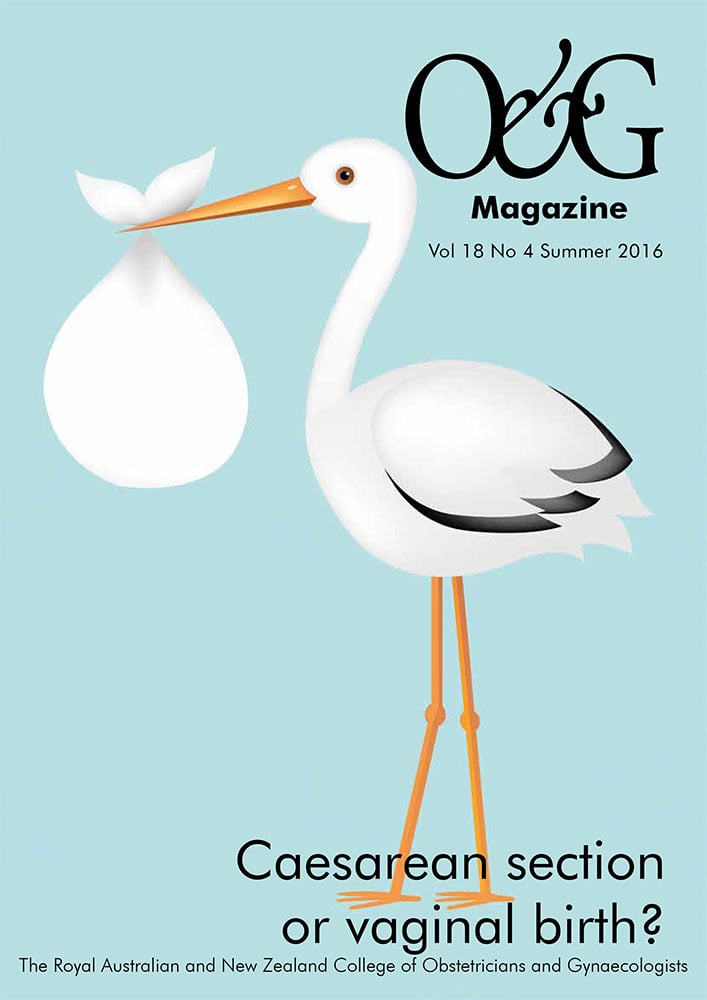Is there a prospect of there ever being a randomised controlled trial of caesarean section (CS) versus vaginal birth (VB) for uncomplicated singleton term pregnancies? In short, the answer is no!
Despite intermittent calls and support for the performance of a large randomised controlled trial investigating the risks and benefits of elective CS versus VB for uncomplicated singleton term pregnancies, it is unlikely that this will ever occur. The idea seems to go in and out of fashion, but has never really taken off. Let’s look at why this might be, from the perspective of the key stakeholders.
The women
As those of us who work in antenatal clinics and labour wards day-to-day are aware, pregnancy, labour and birth are an emotive and highly personal event in the life of a woman and her family. Many women enter pregnancy with an idea of what they wish the experience to be, or what they imagine it will be like. Surveys of healthy, low-risk, nulliparous women have revealed an overwhelming preference for VB over CS, if given the choice.1 2 The main reasons given by women for this preference included that it was viewed as a more ‘natural’ way to give birth, and had a quicker recovery, as well as the avoidance, or fear, of surgery.3
From a patient recruitment point of view, it is likely that recruitment for a randomised trial of elective CS versus VB would be a hard sell. Antenatal patients approached about being recruited to a hypothetical trial of elective CS versus VB revealed less than 15 per cent of those women approached would willingly participate in such a trial.4 5 This reluctance to be randomised to a mode of birth was also evident in the vaginal birth after caesarean (VBAC) study6 in which only 22 women, of 2345 women recruited, were willing to be randomised to VBAC or elective repeat CS.
It is apparent therefore, based on the current literature and the daily experience of working with pregnant women, that women tend to have a preference for mode of delivery coming into and throughout their pregnancies, even without any prior birth experiences. In addition, they are unwilling to have that choice/option taken away from them for the purpose of the performance of a randomised controlled trial. From a practical point of view, recruitment for such a study would likely be prohibitively long term and slow.
The doctors
Despite sometimes heated debates among clinicians as to the role and safety of various modes of birth, the majority of clinicians would be unwilling to support and participate in such a randomised controlled trial.7 The main reason given for unwillingness to recruit to such a trial was the fact that VB was seen as physiological and the most appropriate way to deliver in the absence of obstetric indication otherwise.8 Pregnancy, labour and delivery are still seen by the majority of women and healthcare providers as a physiological process that should be allowed to run its natural course, with potential need for medical intervention only when necessary.
In a survey of healthcare providers, there was a lack of willingness to personally be recruited to, or recruit for, a hypothetical randomised controlled trial of elective CS versus normal VB.9 The healthcare providers surveyed in this study included a random sample of RANZCOG Fellows, subspeciality urogynaecologists, colorectal surgeons and midwives.
The majority of midwives, RANZCOG Fellows and colorectal surgeons surveyed were unwilling to personally (or have their partner) participate in such a trial, however, interestingly, 50 per cent of urogynaecologists surveyed stated they were willing to personally participate.10 This could be a product of relatively few urogynaecologists included in this survey (n=12), or a result of the fact that one of the main arguments for elective CS as a mode of delivery is avoidance of damage to the pelvic floor and future pelvic organ prolapse, which is predominantly an issue of concern to urogynaecologists.
There is also an overwhelming feeling among clinicians that ‘the relative complications of natural vaginal delivery and elective CS were too complex to be answered by an RCT’.11 This raises the issue of what clinically relevant outcomes would be investigated in such a study, and whether they would be considered sufficient impetus for a clinician to recommend an elective CS with no medical indication to a woman – would it be about the pelvic floor, necessitating large numbers and decades of follow-up for a conclusive answer? Would it be a maternal mortality/morbidity outcome, also necessitating prohibitively large numbers, but shorter follow-up? Would it be a neonatal outcome, which may not adequately predict the later childhood outcomes, as was seen in the two-year follow up of the Term Breech Trial?12 What would be sufficiently convincing for clinicians to consider changing the prevailing overwhelming view that VB is the way the majority of low-risk term singleton pregnancies should deliver?
The research
While a randomised controlled trial is considered the pinnacle of evidence-based medicine, it is not always either warranted or ethical to perform one. At its core, research should be performed when there is a clinical question that requires an answer and there is honest doubt and disagreement among the clinical community as to the best treatment for patients, sometimes termed ‘equipoise’. The presence of doubt and disagreement in medicine is termed ‘collective equipoise’, and has previously been defined as being present if at least 70 per cent of clinicians favour one treatment, and 30 per cent of clinicians another.13 In the absence of sufficient clinical collective equipoise, as to one particular treatment over another, it would be considered unethical to randomise participants. This would appear to be the case with regards to the question of mode of delivery in the absence of medical indication,14 such that performing a randomised controlled trial would be unethical and unacceptable.
It has been estimated that up to 3000 women would need to be recruited and randomised to provide adequate power to a study looking at the relative risks and benefits of elective CS versus VB for a composite of maternal short-term morbidity or urinary incontinence at three months’ postnatal.15 It is likely that such numbers would require in the order of five to 10 years of active recruitment to achieve, making it unlikely that such a study would be funded or ever proposed. With regards to short-term neonatal outcomes, numbers required would likely be lower, in the order of 600–1500 women; however, as mentioned previously, neonatal outcomes do not necessarily predict later childhood outcomes. Longer-term, but potentially more clinically important, outcomes, such as cerebral palsy or pelvic organ prolapse, would require much larger initial numbers to allow for attrition and loss to follow up over prolonged periods of time.
Large, well-designed randomised controlled trials require significant amounts of funding, and research funding is becoming increasingly scarce. All applications for funding through major bodies in Australia (for example, National Health and Medical Research Council and Australian Research Council) go through rigorous peer-review processes, and only the minority of applications are accepted and awarded funding. In light of the lack of clinician acceptance, and large numbers and long periods for recruitment and follow up, it is unlikely such a study would succeed in this environment.
References
- Mazzoni A, et al. Women’s preferences and mode of delivery in public and private hospitals: a prospective cohort study. BMC Pregnancy Childbirth. 2016;16:34.
- Liu NH, et al. Preferences for mode of delivery in nulliparous Argentinean women: a qualitative study. Reprod Health. 2013;10(1):2.
- Mazzoni A, et al. Women’s preferences and mode of delivery in public and private hospitals: a prospective cohort study. BMC Pregnancy Childbirth. 2016;16:34.
- Lavender T and Kingdon C. Primigravid women’s views of being approached to participate in a hypothetical term cephalic trial of planned vaginal birth versus planned cesarean birth. Birth. 2009;36(3):213-9.
- Turner CE, et al. Willingness of pregnant women and clinicians to participate in a hypothetical randomised controlled trial comparing vaginal delivery and elective caesarean section. ANZJOG. 2008;48(6):542-6.
- Crowther CA, et al. Planned vaginal birth or elective repeat caesarean: patient preference restricted cohort with nested randomised trial. PLoS Med. 2012;9(3):e1001192.
- Turner CE, et al. Willingness of pregnant women and clinicians to participate in a hypothetical randomised controlled trial comparing vaginal delivery and elective caesarean section. ANZJOG. 2008;48(6):542-6.
- Turner CE, et al. Willingness of pregnant women and clinicians to participate in a hypothetical randomised controlled trial comparing vaginal delivery and elective caesarean section. ANZJOG. 2008;48(6):542-6.
- Turner CE, et al. Willingness of pregnant women and clinicians to participate in a hypothetical randomised controlled trial comparing vaginal delivery and elective caesarean section. ANZJOG. 2008;48(6):542-6.
- Turner CE, et al. Willingness of pregnant women and clinicians to participate in a hypothetical randomised controlled trial comparing vaginal delivery and elective caesarean section. ANZJOG. 2008;48(6):542-6.
- Turner CE, et al. Willingness of pregnant women and clinicians to participate in a hypothetical randomised controlled trial comparing vaginal delivery and elective caesarean section. ANZJOG. 2008;48(6):542-6.
- Whyte H, et al. Outcomes of children at 2 years after planned cesarean birth versus planned vaginal birth for breech presentation at term: the International Randomised Term Breech Trial. Am J Obstet Gynecol. 2004;191(3):864-71.
- Johnson N, Lilford RJ, Brazier W. At what level of collective equipoise does a clinical trial become ethical? J Med Ethics. 1991;17(1):30-4.
- Turner CE, et al. Willingness of pregnant women and clinicians to participate in a hypothetical randomised controlled trial comparing vaginal delivery and elective caesarean section. ANZJOG. 2008;48(6):542-6.
- Once a pregnancy, always a cesarean? Rationale and feasibility of a randomised controlled trial. Am J Obstet Gynecol. 2004;190(2):314-8.







Leave a Reply